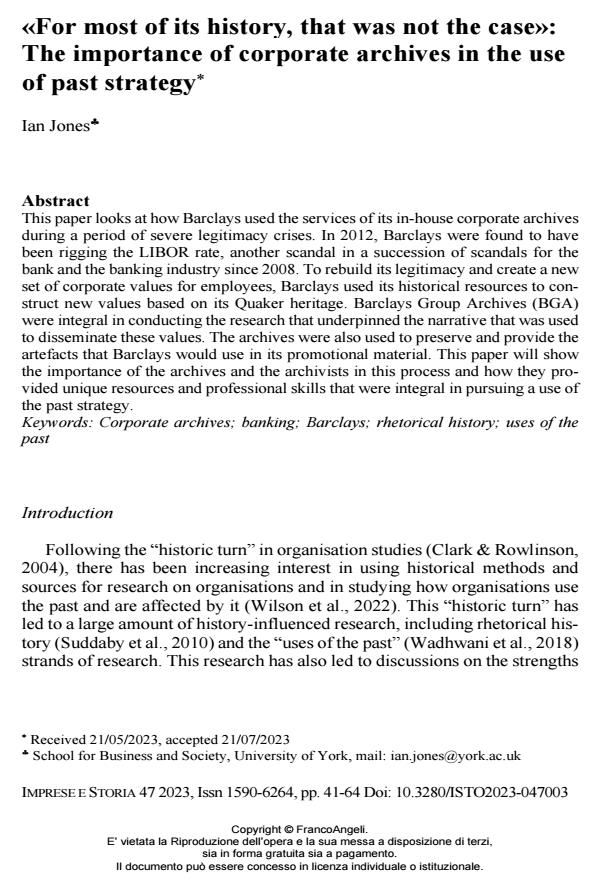«For most of its history, that was not the case»: The importance of corporate archives in the use of past strategy
Journal title IMPRESE E STORIA
Author/s Ian Jones
Publishing Year 2024 Issue 2023/47
Language English Pages 24 P. 41-64 File size 229 KB
DOI 10.3280/ISTO2023-047003
DOI is like a bar code for intellectual property: to have more infomation
click here
Below, you can see the article first page
If you want to buy this article in PDF format, you can do it, following the instructions to buy download credits

FrancoAngeli is member of Publishers International Linking Association, Inc (PILA), a not-for-profit association which run the CrossRef service enabling links to and from online scholarly content.
This paper looks at how Barclays used the services of its in-house corporate archives during a period of severe legitimacy crises. In 2012, Barclays were found to have been rigging the LIBOR rate, another scandal in a succession of scandals for the bank and the banking industry since 2008. To rebuild its legitimacy and create a new set of corporate values for employees, Barclays used its historical resources to con- struct new values based on its Quaker heritage. Barclays Group Archives (BGA) were integral in conducting the research that underpinned the narrative that was used to disseminate these values. The archives were also used to preserve and provide the artefacts that Barclays would use in its promotional material. This paper will show the importance of the archives and the archivists in this process and how they pro- vided unique resources and professional skills that were integral in pursuing a use of the past strategy.
Keywords: Corporate archives; banking; Barclays; rhetorical history; uses of the past
- Board composition in the ‘Big Four’ British clearing banks, 1970-2005: A prosopographic and theoretical analysis Ian G. Jones, John F. Wilson, Anna Tilba, Mitchell J. Larson, in Business History /2025 pp.1
DOI: 10.1080/00076791.2025.2550738 - Marking history and making history: Genres of internal historical narratives in rhetorical history Michael Heller, Joe Chick, Michael Rowlinson, in Business History /2026 pp.1
DOI: 10.1080/00076791.2025.2597753
Ian Jones, «For most of its history, that was not the case»: The importance of corporate archives in the use of past strategy in "IMPRESE E STORIA" 47/2023, pp 41-64, DOI: 10.3280/ISTO2023-047003